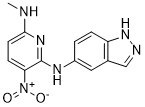| Cas No.: | 342639-96-7 |
| Chemical Name: | Kribb11 |
| Synonyms: | KRIBB11;KRIBB-11;N2-(1H-indazol-5-yl)-N6-methyl-3-nitropyridine-2,6-diamine;N2-(1H-indazole-5-yl)-N6-methyl-3-nitropyridine-2,6-diamine;BCP19297;s8402;BDBM50114871;AK685532;A16347;N2-1H-Indazol-5-yl-N6-methyl-3-nitro-2,6-pyridinediamine;N-(1H-Indazole-5-yl)-N'-methyl-3-nitropyridine-2,6-diamine;2-N-(1H-indazol-5-yl)-6-N-methyl-3-nitropyridine-2,6-diamine |
| SMILES: | O=[N+](C1=CC=C(NC)N=C1NC2=CC3=C(NN=C3)C=C2)[O-] |
| Formula: | C13H12N6O2 |
| M.Wt: | 284.2734 |
| Purity: | >98% |
| Sotrage: | 4°C for 1 year, -20°C for more than 2 years |
| Description: | KRIBB11 is an inhibitor of Heat shock factor 1 (HSF1), with IC50 of 1.2 μM. |
| In Vivo: | KRIBB11 (50 mg/kg, i.p.) results in a 47.4% inhibition of tumor growth in nude mice, without body weight loss[1]. |
| In Vitro: | KRIBB11 blocks the induction of HSF1 downstream target proteins such as HSP27 and HSP70. KRIBB11 induces growth arrest and apoptosis of HCT-116 cells. KRIBB11 inhibits HSF1-dependent recruitment of p-TEFb (positive transcription elongation factor b) to the hsp70 promoter[1]. PARP and caspase-3 cleavage is increased in cells treated with KRIBB11. Incubating RKO with KRIBB11, shows a toxic threshold of about 10 µM, and an IC50 of 20-30 µM[2]. |
| Kinase Assay: | HCT-116 cells are washed with PBS and then homogenized with a 27-gauge syringe in binding buffer (10 mm Tris-HCl (pH 7.4), 50 mm KCl, 5 mm MgCl2, 1 mm EDTA, and 0.1 mm Na3VO4). The cell lysate is centrifuged at 13,000 rpm for 30 min at 4°C, and the supernatant is collected. The HCT-116 cell lysate supernatant is precleared by incubating with Dynabeads M-280 streptavidin for 30 min at 4°C and captured by magnet separation. The cleared supernatants are incubated with biotinyl-KRIBB11 compound. After overnight incubation at 4°C, proteins associated with the biotinyl-KRIBB11 compound are precipitated with Dynabeads M-280 streptavidin. Precipitated samples are separated by a magnet. Samples are washed with 1 mL of ishing buffer containing 50 mm HEPES (pH 7.5), 50 mm NaCl, 1 mm EDTA, 1 mm EGTA, 0.1% Tween 20, 10% (v/v) glycerol, 1 mm NaF, 0.1 mm Na3VO4, and protease inhibitor mixture tablets (1 tablet/10 mL). Samples are boiled in SDS-PAGE sample buffer, separated by 10% polyacrylamide gel, and immunoblotted with antibodies against HSF1, HSF2, HSP90, or CDK9. |
| Cell Assay: | Cells are seeded onto 96-well plates at a density of 6×103 cells per well in McCoy's 5A medium with 10% FBS. After 24 h, the medium is replenwashed with fresh complete medium containing chemicals or 0.1% DMSO. After incubation for 48 h, the cell proliferation reagent WST-1 is added to each well. The amount of WST-1 formazan produced is measured at 450 nm using an ELISA reader. |
| Animal Administration: | Seven-week-old female inbred specific pathogen-free Balb/c nude mice are housed under sterile conditions with 12-h light/dark cycles, and fed food and water ad libitum. For the evaluation of the in vivo anti-tumor activity of KRIBB11, HCT-116 cells (0.3 mL of 4×107 cells/mL) are implanted subcutaneously into the right flank of the mice on day 0. KRIBB11 is dissolved in 10% dimethylacetamide, 50% PEG300, and 40% distilled water. When the size of tumors reached 72.2 mm3, the compound is administered intraperitoneally at a dose of 50 mg/kg/day for 18 days. Tumor volumes are estimated by using the formula length (mm) × width (mm) × height (mm)/2. To determine the toxicity of the compound, the body weight of tumor-bearing animals is recorded. On day 18, the mice are sacrificed, and the tumors are weighed. |
| References: | [1]. Yoon YJ, et al. KRIBB11 inhibits HSP70 synthesis through inhibition of heat shock factor 1 function by impairing the recruitment of positive transcription elongation factor b to the hsp70 promoter. J Biol Chem. 2011 Jan 21;286(3):1737-47. [2]. Samarasinghe B, et al. Heat shock factor 1 confers resistance to Hsp90 inhibitors through p62/SQSTM1 expression and promotion of autophagic flux. Biochem Pharmacol. 2014 Feb 1;87(3):445-55. Chemical & Physical Properties |

 DC Chemicals' products qualify for U.S. tariff exemptions. We guarantee no price increases due to customs duties and maintain stable supply, continuing to deliver reliable research solutions to our American clients.
DC Chemicals' products qualify for U.S. tariff exemptions. We guarantee no price increases due to customs duties and maintain stable supply, continuing to deliver reliable research solutions to our American clients.





















